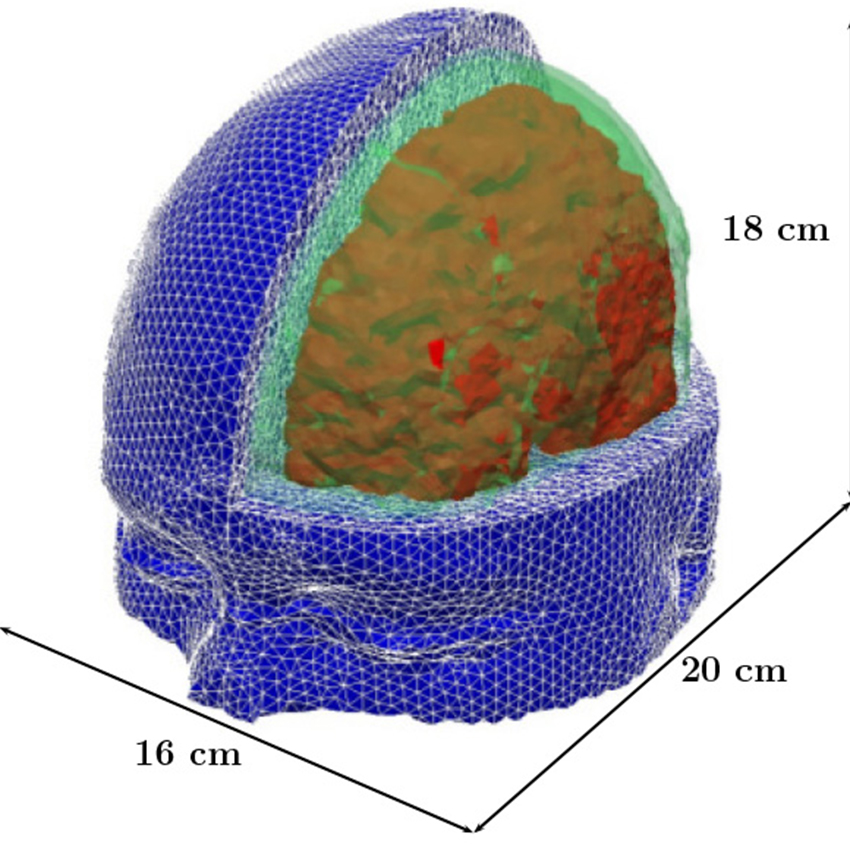MIT Is Working to Estimate Risk of Blast-Induced Traumatic Brain Injury

MIT researchers have developed a model of the human head for use in simulations to predict the risk for blast-induced traumatic brain injury. Relevant tissue structures include the skull (green), brain (red), and flesh (blue). Image provided by MIT
Among soldiers admitted to Walter Reed Army Medical Center, 30 percent have been diagnosed with traumatic brain injury (TBI), according to the Brain Trauma Foundation. Symptoms of TBI can range from lingering headaches and nausea, to severe impairments in memory and cognition.
Many government agencies, research institutions, and universities have been working on ways to address this problem. MIT researchers, for example, have been studying how to estimate the risk of blast-induced TBI. The researchers developed a “scaling law” by looking at previous studies of what happened to animal brains after a blast. This new method may be able to help the military develop more protective helmets and, perhaps, aid clinicians in diagnosing TBI, commonly referred to as the “invisible wounds” of battle.
The MIT team is working with the U.S Army, and together they published a new paper on their work in the journal, Proceedings of the National Academy of Sciences.
“We’re really focusing on mild traumatic brain injury, where we know the least, but the problem is the largest,” says Raul Radovitzky, a professor and associate director of the MIT Institute for Soldier Nanotechnologies (ISN). “It often remains undetected. And there’s wide consensus that this is clearly a big issue.”
Previous scaling laws have predicted that the human brain is more resilient to blasts than the animal brain, but Radovitzky’s team found that is not the case. Humans are actually more vulnerable, because they have thinner skulls that protect a much larger brain, Radovitzky says.
Radovitzky’s team set up blasts of varying strengths on human, pig, and rat heads. The simulations, according to MIT reps, “predicted the effects of the blasts’ shockwaves as they propagated through the skulls and brains of each species. Based on the resulting differences in intracranial pressure, the team developed an equation, or scaling law, to estimate the risk of brain injury for each species.”
“The great thing about doing this on the computer is that it allows you to reduce and possibly eventually eliminate animal experiments,” Radovitzky says.
This is how the study got started, according to an MIT report:
In 2010, Radovitzky’s group, working in concert with the Defense and Veterans Brain Injury Center, a part of the U.S. military health system, developed a highly sophisticated, image-based computational model of the human head that illustrates the ways in which pressurized air moves through its soft tissues. With this model, the researchers showed how the energy from a blast wave can easily reach the brain through openings such as the eyes and sinuses — and also how covering the face with a mask can prevent such injuries. Since then, the team has developed similar models for pigs and rats, capturing the mechanical response of brain tissue to shockwaves.
In their current work, the researchers calculated the vulnerability of each species to brain injury by establishing a mathematical relationship between properties of the skull, brain, and surrounding flesh, and the propagation of incoming shockwaves. The group considered each brain structure’s volume, density, and celerity — how fast stress waves propagate through a tissue. They then simulated the brain’s response to blasts of different intensities.
In general, they found that an animal’s skull and other fleshy structures act as a shield, blunting the effects of a blast wave: The thicker these structures are, the less vulnerable an animal is to injury. Compared with the more prominent skulls of rats and pigs, a human’s thinner skull increases the risk for traumatic brain injury.
Radovitzky and his group are collaborating with the Army to perform basic research to help the Army develop helmets that better protect soldiers. His team is also working with audiologists at Mass General, who are treating Boston Marathon bombing victims with ruptured eardrums.
“[The audiologists at Mass General] have an exact map of where each victim was, relative to the blast,” Radovitzky says. “In principle, we could simulate the event, find out the level of exposure of each of those victims, put it in our scaling law, and we could estimate their risk of developing a traumatic brain injury that may not be detected in an MRI.”


